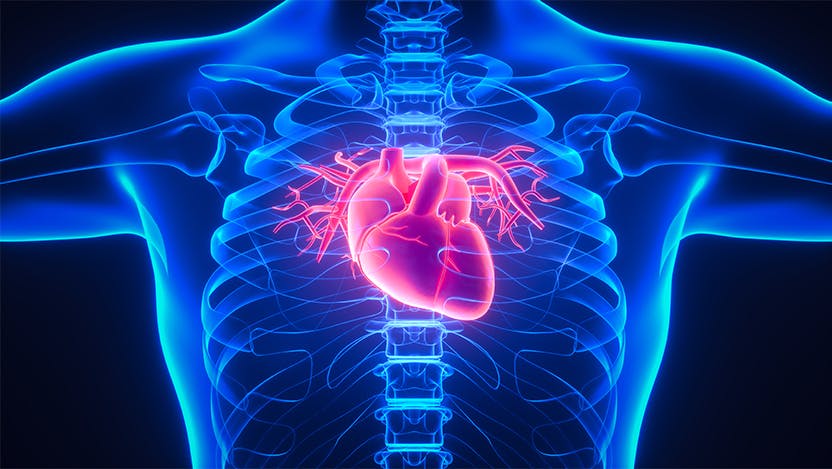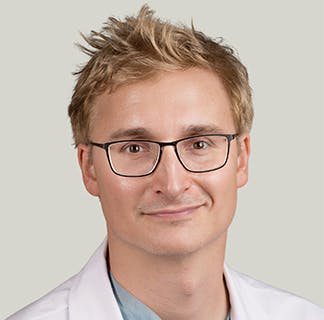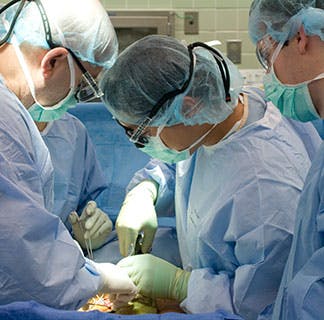How understanding patient anatomy can lead to more personalized treatments for aortic dissections

As a vascular surgeon at the University of Chicago Medicine, I’ve focused my research on improving treatment for aortic dissections, a condition in which the inner lining of the aorta — the largest artery in the body — becomes weakened and torn. Learn more about advances in vascular surgery, and how better understanding each patient's aortic anatomy can lead to more personalized treatment.
There is a traditional risk-reduction surgery that can prevent an aortic dissection from becoming a bigger problem that will be life-threatening. The problem is that the death rate of that operation is 20% to 30%. So, the question remains: When do you intervene? Do you say to the patient, “There’s a one-in-three chance you won’t survive surgery, but the surgery will improve your odds — not tomorrow or next week or next month or in six months, but maybe in six years?" And no one has been able to answer that. Newer endovascular surgeries exist, but they are not appropriate for every patient anatomy, which is another difficulty in deciding on whom to operate.
Then the next step is determining what course of action to take with the patients who are not good candidates for current technologies. They still need something. So, what we also need is a redesign of endovascular grafts. The stent grafts used to treat dissections were originally designed as an offshoot of a fairly successful technology to treat abdominal aneurysms. The problem is that the technology does not work well when the geometry of the aorta becomes highly tortuous, or full of curves. Over time, the graft and the aorta may not couple as well, and blood can begin to leak around the graft. Optimizing graft geometry so that it fits a person’s aortic geometry is the holy grail for where endovascular technology needs to go in the next 10 years.
What are aortic dissections, and how common are they?
Dissection is a blistering or cracking of part of the aortic wall. If the entire aortic wall ruptures, it's a life-threatening emergency. If there is a partial crack that doesn’t go all the way through, that is an aortic dissection. It is not immediately life threatening but can become life threatening over time. As the blister weakens and grows, it can become an an aneurysm — a weakening or bulging of an artery wall — and can rupture.Why are aortic dissections so hard to treat?
Often in medicine, the more life-threatening the problem, the easier the clinical decision. However, in the majority of patients, dissections are not imminently deadly. And yet, clearly there's something unstable in their aorta, because this big blood vessel has a crack.There is a traditional risk-reduction surgery that can prevent an aortic dissection from becoming a bigger problem that will be life-threatening. The problem is that the death rate of that operation is 20% to 30%. So, the question remains: When do you intervene? Do you say to the patient, “There’s a one-in-three chance you won’t survive surgery, but the surgery will improve your odds — not tomorrow or next week or next month or in six months, but maybe in six years?" And no one has been able to answer that. Newer endovascular surgeries exist, but they are not appropriate for every patient anatomy, which is another difficulty in deciding on whom to operate.
What sets UChicago Medicine apart in its approach to aortic dissection patients?
At UChicago Medicine, we love finding innovative solutions to challenging problems, and aortic dissection, as it concerns aortic pathologies, is among the most challenging. It can’t be categorized into a cookie-cutter approach. What we’re trying to do at the Center for Aortic Diseases within UChicago Medicine’s Heart and Vascular Center is to be innovative and thoughtful with each dissection patient. We now have a multidisciplinary aortic conference each month that includes vascular surgery, cardiac surgery and our cardiology colleagues, where we review each patient and come up with a consensus as to what is the best approach. It’s truly about personalization and extracting the maximum amount of information that we can from the data that’s been collected on the patient.How is your research translating data into better patient care?
The heart of our research is to try to more fully use the information we have about patients — especially as it concerns the geometry and shape of their aortas and aortic dissections — to better determine a patient’s potential risks. Traditionally, the main parameter surgeons look at to decide whether an aorta is healthy or not healthy is the diameter of the aorta at its largest point. It’s a very simplistic measurement. The thrust of my research is to use more modern tools from differential geometry, topology and computer science to better define the geometric features that tell us about the stability of the aorta, so we can better assess and determine when the risks of surgery are worth it and when they are not. I work with very simple data in the sense that I just need a CT scan. So, even if a patient arrives at our center from another hospital, we can do our analysis with information that's gathered anywhere.What innovations do you see on the horizon for vascular surgery?
The No. 1 innovation that needs to happen in the next five years is better patient selection for the surgical technologies that we currently have. With the endovascular grafts on the market right now, which patients would clearly benefit from using them? That’s achievable.Then the next step is determining what course of action to take with the patients who are not good candidates for current technologies. They still need something. So, what we also need is a redesign of endovascular grafts. The stent grafts used to treat dissections were originally designed as an offshoot of a fairly successful technology to treat abdominal aneurysms. The problem is that the technology does not work well when the geometry of the aorta becomes highly tortuous, or full of curves. Over time, the graft and the aorta may not couple as well, and blood can begin to leak around the graft. Optimizing graft geometry so that it fits a person’s aortic geometry is the holy grail for where endovascular technology needs to go in the next 10 years.

Luka Pocivavsek, MD, PhD
Luka Pocivavsek, MD, PhD, is a highly skilled vascular surgeon who specializes in a wide range of vascular conditions, including peripheral vascular, cerebrovascular disease and aortic disease.
Learn more about Dr. Pocivavsek
Center for Aortic Diseases
For over 100 years, the world-renowned clinicians and scientists at the University of Chicago Medicine have specialized in the diagnosis, care and management of all types of aortic conditions.
Explore our aortic disease services